As a guitar teacher of 20+ years, I've seen my fair share of online lesson platforms come and go. One of the sites that stuck around is TrueFire.com.
52,000? Lessons from world-renowned artists like Steve Vai and Tommy Emmanuel? Sounds impressive...
So for the last year or so, I've been using Truefire regularly for many of my practice sessions. I dove into the vast lesson universe of TrueFire, completed a few courses, tried all the features, and so on.
In this no-holds-barred review, I'll give you an insider's perspective on what works, and reveal what doesn't.
Helicopter Overview of TrueFire.com
TrueFire has been teaching guitar since 1991. It started with VHS tapes and transferred to online lessons in the 2010s. TrueFire also owns ArtistWorks.com, and acquired Jamplay.com in 2022 as well, adding all of its lessons to the TrueFire library.

Tom's take on Truefire.com
TrueFire is the biggest online guitar lesson website with a massive library of video lessons in all genres and difficulty levels. The large number of tutorials will not be easy to manage for beginners, but intermediate and advanced guitar players will definitely find courses to their liking.
Pros
Cons
Best for:
Price:
Discounts:
Free trial:
out of 10
The site currently offers:
- Over 52,000 video lessons
- 1,000+ courses
- 300+ instructors
That's a lot... In fact, it is probably more than all of the other major sites combined.
Is it lesson overload though? In a way, yes, I'll talk about why a bit later.
The educators are top-notch, including:
- GRAMMY winners
- Renowned session players
- Acclaimed teachers
You'll learn from guitar legends like Steve Vai, Tommy Emmanuel, Larry Carlton, and Robben Ford to name a few. It is a real treat to see such huge names talking about their style and trying to teach it.
Lessons cover every skill, level, and style, such as:
- Beginner basics to advanced techniques
- Blues, metal, country, and more
The library constantly expands with fresh material, and the lessons are shot in HD with high-quality audio and multiple camera angles. The video player has slo-mo, looping, and synced tabs using SoundSlice.
You can also get 1-on-1 "private" lessons with a few instructors (not live, but with video-based personal feedback), and advanced guitarists can jam along with "In the Jam" video tracks.
So that was the more general part of my Truefire review, let me move on to the more interesting parts.
Lesson Structure and Content
Structuring the massive (and growing) library of lessons is not easy. Can it be done effectively though?
Truefire has 2 main strategies for this:
- Learning Paths
- Individual Courses
How Learning Paths Work
TrueFire's Learning Paths aim to provide a structured approach for learning larger topics.
At present, they have Learning Paths for the following genres:
- Blues (17 Core section courses, 172 Supplementary courses),
- Jazz (18 Core section courses, 153 Supplementary courses),
- Rock (17 Core section courses, 210 Supplementary courses),
- Acoustic (17 Core section courses, 161 Supplementary courses),
- Country (13 Core section courses, 98 Supplementary courses),
- Bass (7 Core section courses, 37 Supplementary courses).
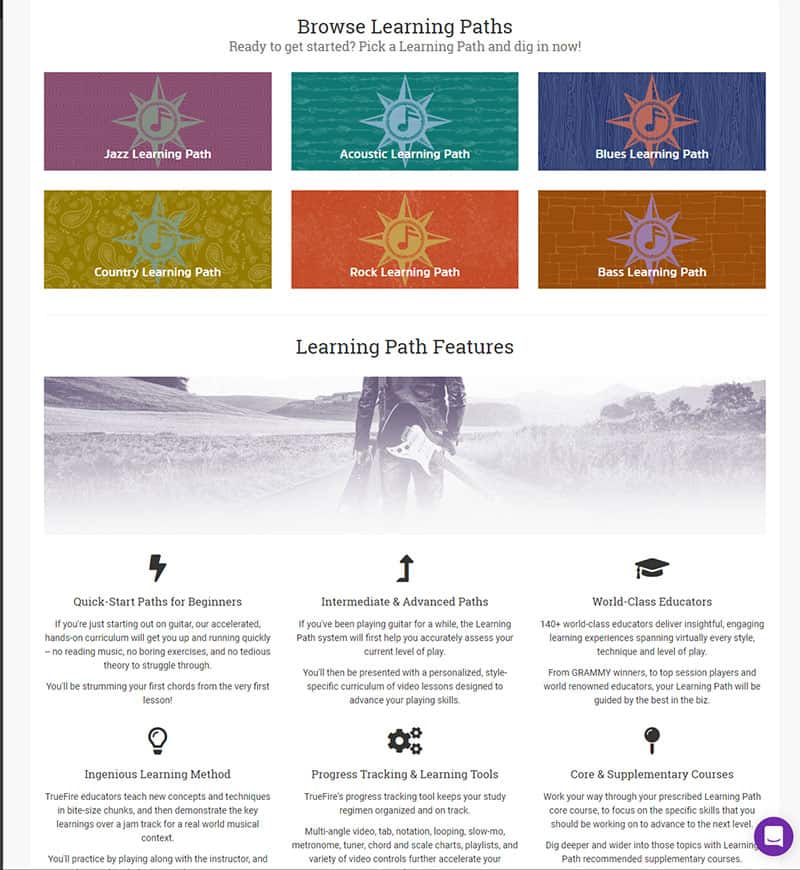
I took the time to count how many courses are in each path, and there are a lot as you can see above.
Each guitar Learning Path has 13-17 core sections, with 30+ video lessons in each section. Additionaly, each Core section has a whipping 5-25 supplementary courses recommended (each with 30 to 60 lessons as well) for those of us who want to dive super deep into a topic.
Add this up, and it's bonkers.
Let's calculate the amount of material in the Acoustic Path, for example:
- Let's use 6 minutes as the average video length, 40 videos per Core section and Supplementary course
- The total runtime of the Acoustic path = 6x40x(17+161) = 42,720 minutes = 712 hours
Ummm.....
That's a TON of material to go through! About 5 years' worth of material, if you practice 5 times a week for an hour.
So with each Learning Path, beginners start with the basics like holding the guitar, basic chords, rhythm, etc. The Path gets progressively more difficult, and the advanced stuff is no joke - think Joe Bonamassa teaching blues guitar during session recordings, or Fingerstyle Milestones from Tommy Emmanuel in core level 5 of the Acoustic Path...
I've been playing for 25+ years, but I always find new, challenging things to learn.
However, I've noticed that the Learning Paths can be disjointed at times. The individual lessons are pulled from various courses, so it can feel like dropping into the middle of a conversation without context.
TrueFire does not hide this:
...core curriculum is comprised of select acoustic guitar lessons from the educators' existing TrueFire course libraries.
As such, I feel that a lot of times you get to learn a lot of separate things, but they are not always naturally connected and can leave you sort of hanging, without being able to put it all together.
Also, there are many teachers in any given Core section of a Learning Path. Every teacher has a different style, some are good, some not so. You can't stick with a single teacher though, since the lessons are picked from various courses.
So even though the Learning Paths are as structured as they can be, I am not that satisfied with them. There is just too much material, which doesn't all fit together seamlessly.
Individual Courses
Learning Paths are not the only way to learn on True Fire.
If you're more advanced, you can explore the thousands of standalone courses on offer, covering everything from classical to flamenco to "must-know" licks. The search function makes it easy to find what you need, and with any given topic, you'll literally get year's worth of lessons.
Learning from these individual courses is best for higher intermediate and advanced players who no longer need the Learning Paths' linear structure.
With this many courses though, some are not so great. It sometimes felt like a hit or miss, trying a course and swapping to another one after a few lessons. Some courses are good, but some have a boring teacher, incoherent course lessons, or both.
But with that said, you'll still find dozens of good courses on any wider topic you want to learn, and at least 5+ on the narrowest of topics.
Which Is Better?
TrueFire's lesson structure caters to all types of guitar students.
The Learning Paths provide guidance for beginners, while the individual courses offer flexibility for advanced guitarists. With some self-direction, you can craft a learning experience that works for you.
The sheer volume of content can be overwhelming though, especially for beginners, and the site design doesn't always make things easy to find. Just look at the navigational menu, I still have trouble with it:
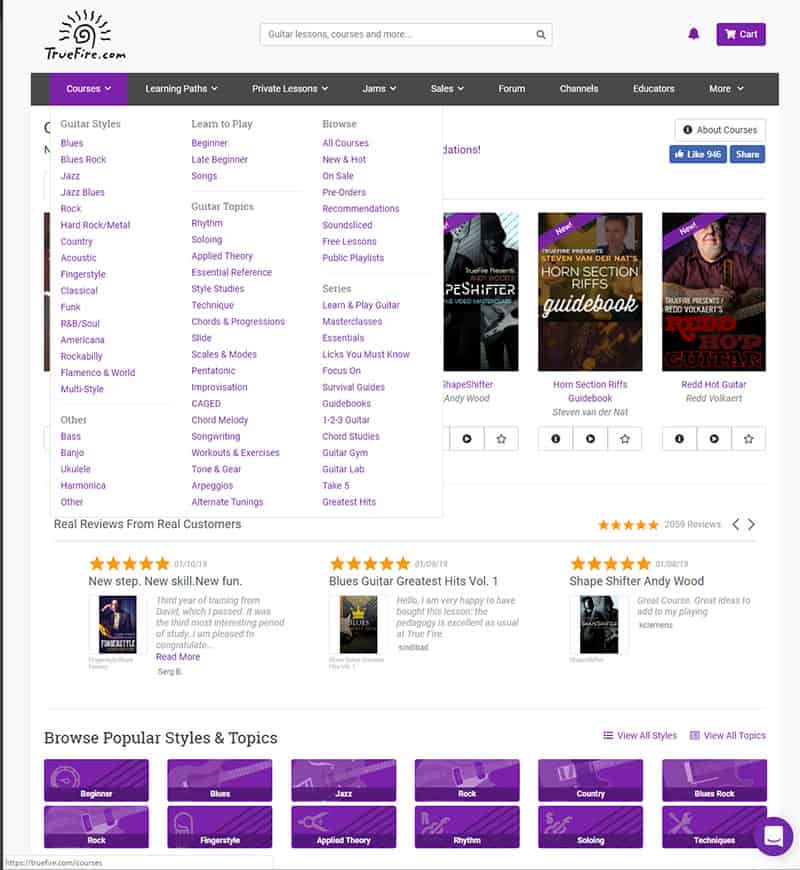
Learning Experience
Now let's have a look at what the overall learning experience is like.
Navigating The Lessons
With this many lessons, finding the right lesson can become quite a challenge.
The site navigation looks simple on the surface, you can see it on the image above, but digging in reveals some quirks.
- The dropdown menus make it easy to browse by style, instructor, skill level.
- You can further refine a topic search, so for example, choose Intermediate lessons on the Country lessons page.
- But sometimes, the filtering just doesn't work, and I get thrown over to unrelated lessons. Obviously, I won't start them, but it makes finding things harder. The lesson filtering needs some improvement, especially with this volume of material. The 52,000+ lessons can feel like drinking from a firehose...
I often found myself going down rabbit holes, jumping between courses without a clear path. The Learning Paths aim to solve this, but as I said, they feel a bit disjointed, like a greatest hits compilation rather than a cohesive album.
Also, the search function does not return anything in the instructors' tab. It would be nice to see my favorite educators listed when I search for genre or technique. But maybe this is just a temporary error.
Interface on Individual Lesson Pages
The actual lesson user interface is top-notch.
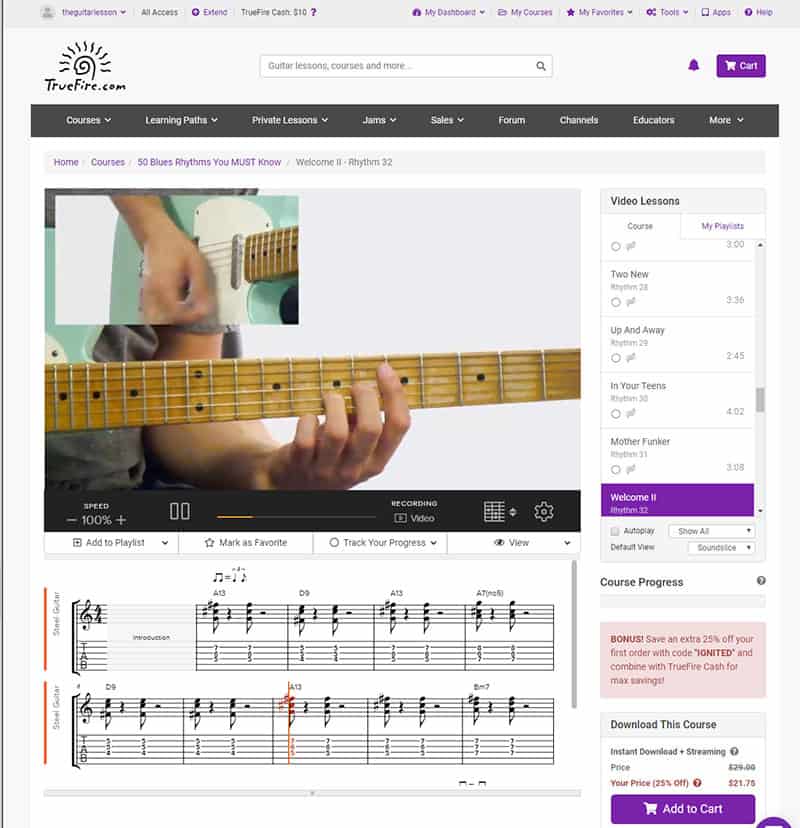
- Multiple camera angles show you exactly what's being played.
- You can slow down, loop, and jump to any section with ease
- The Soundslice integration is cool, syncing the video with tab and notation, and even the animated fretboard. Seeing the tab/notation scroll in real-time with the video makes learning so much easier. It's what I've been doing with my own lessons on TheGuitarLesson.com since forever.
- Progress tracking, while manual, helps you stay organized.
Private Lessons... Sort of
In addition to its extensive library of pre-recorded courses, TrueFire offers private online lessons with its top educators. This allows you to get personalized instruction and feedback from a number of their teachers via video messaging.
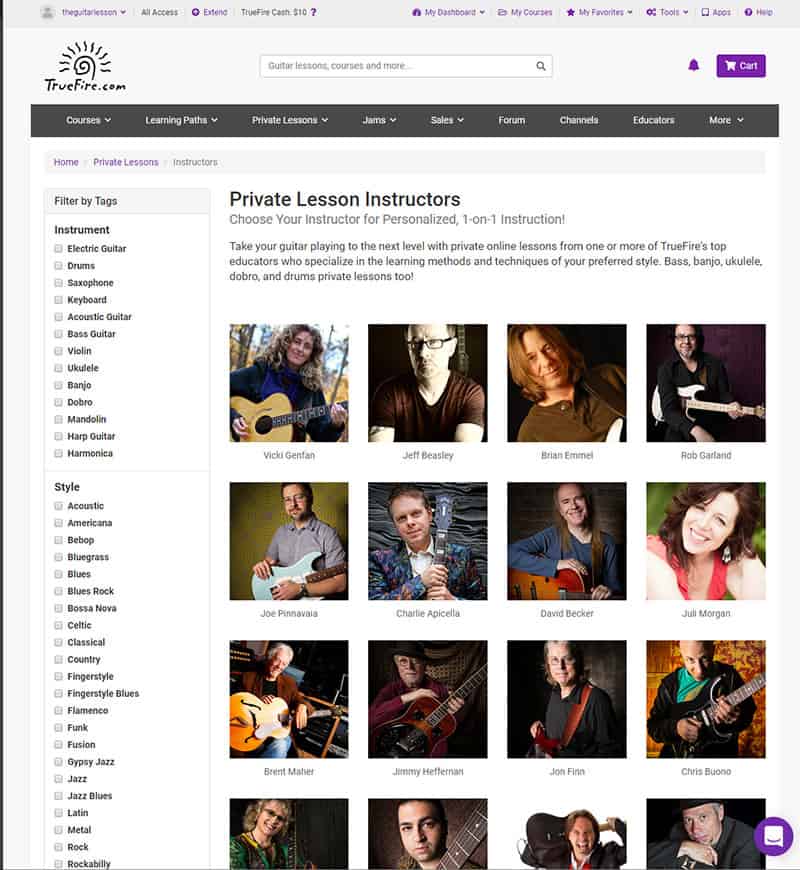
It is not live, but it is private and tailored to you. This is how it works:
- You record video of yourself playing,
- Pay the fee for the private video exchange,
- Send it to the instructor using TrueFire's video, audio, and text messaging interface, exchanging tabs, notation, and other files,
- You a personalized lesson video from the instructor answering your questions.
This multimedia approach mimics in-person lessons, but it is not live.
It's rather expensive though, especially for the 1 time lesson. You can see the cost later in the article, but just so you know, GuitarTricks provides this for free.
I wouldn't use this feature unless I was in an absolute guitar rut, or had a crush on a teacher. But unfortunately no, Orianthi does not do these private lessons 😉
Personal Dashboard
As you can expect, your account will create a dashboard where you can keep track of what you're up to.

TrueFire Jams
For advanced guitar players only, the TrueFire Jams section of the site lets you jam along with musicians.
And not just through mp3 files and jam tracks.
The "In The Jam" feature is unique to TrueFire, and requires downloading to a computer. It is a program that puts you into a studio with a real band, playing songs together. You can listen to each band member talk about the given song their approach to playing it, mute any instrument, and jam along as well.
I think this is a very interesting feature for advanced guitar players, since the musicians in the In The Jam sessions are really great and unique.
Dedicated Mobile App and Desktop Program
The True Fire mobile app is excellent. I used it on my Android phone (Pixel 7), but it also has an iPhone version.
It is very easy to use, quick to load, and maybe even easier to navigate. In fact, I mostly used the app, and not the main site, even at home.
The interface is clean and you can access all the same content as the website. The app did crash on me a couple of times though, but nothing major, just a slight annoyance.
One thing I love is the offline download feature, which I always use before flights to download a few lessons to watch without internet. So while most people are watching Netflix on the flight, I am watching people play guitar 🙂 Crazy me? You decide.
The Truefire desktop program is not that great... You can access all of the site's videos, but it is much slower for me than the main site.
Also, sometimes it just didn't load a video, so I didn't use the desktop app much.
It is required for using the "In The Jam" functionality though, but other than that, I see no need for using it at all.

Other tools
There are a few online tools that you get access to, like this tuner:

And a few other things:
- Downloadable tabs for practicing later,
- Chord and scale charts (although the chord charts section looks pretty bad, it is taken over from ex-Jamplay in a very unnatural-looking iframe),
- Jam tracks as a supplement to most video lessons,
- Metronome,
- Tuner,
- You can learn offline with the desktop and mobile apps by downloading the videos.
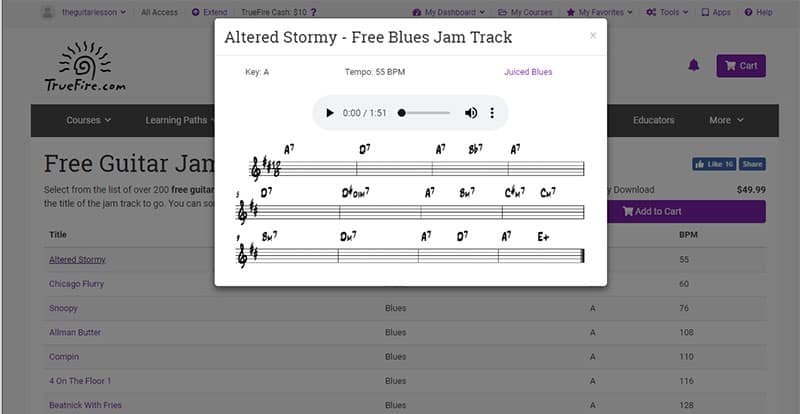
Overall, TrueFire's learning experience is powerful but not perfect. It's an incredible resource, but one that requires patience and self-direction to unlock fully.
Suitability for Different Skill Levels
True Fire has lessons for all skill levels. Here is what you can expect.
As I mentioned, the thousands of lessons in the Learning Path series' are categorized based on skill level as well:
Beginner -> Late Beginner -> Intermediate -> Late Intermediate -> Advanced
Truefire For Beginners
As a beginner, it is important to have direction on your guitar journey so you learn the foundations well. This is the reason you're not learning off YouTube videos.
On TrueFire, this means choosing one of the Learning Paths (blues, jazz, rock, acoustic, country, bass).
The first 2 Core sections are exactly the same in every Path, since the basics of playing guitar are the same in every genre (holding the guitar, basic chords, notes, rhythm, tuning, etc.)
The Paths diverge from Core section 3, and specialize towards whichever genre you choose. So this means you'll need to decide which direction you'll go.
Rock?
Blues?
Country?
Jazz?
Acoustic?
I always recommend going for the type of music you listen to the most.
I found some overlap in the lessons and supplementary courses later on though, especially in the blues and acoustic paths.
But overall, since the lessons feel a bit disjointed at times, and due to the endless nature of the Learning Paths, I think the beginner modules of a competing site, GuitarTricks.com, are better.
You can read about GuitarTricks here.
Truefire For Intermediate and Advanced Players
After using TrueFire for a while, I think the better you are at the guitar, the more you'll get out of the site.
Intermediate players can join in around the 5th Core section of any learning path, and continue on from there.
Advanced players can choose individual courses to refine any given skill they want. The courses are a real treat as they cover all sorts of interesting topics I haven't found anywhere else.
And while guitar stars like Steve Vai may not be the best at teaching, I really liked watching him do his thing and talk about the techniques he uses, and his approach to music.
A standout feature of TrueFire for advanced guitar players is the "In the Jam" feature. You can mix and match video and audio tracks, playing along with a virtual band. It's the closest thing to jamming with real humans (minus the egos and scheduling conflicts).
Overall, I think TrueFire is an absolute goldmine for intermediate and advanced players looking to take their skills to the next level. The instructors, lesson quality, and depth of content are simply unmatched. The only downside is the lack of structure at the advanced level, so you'll need to be proactive in seeking out courses that align with your goals. But with so much high-quality content and courses, that's hardly a complaint.
User Feedback and Reviews
I was interested in what other people think about the site, so I did some digging around. It appears that TrueFire has received mixed reviews from users on platforms like Reddit and Trustpilot.
The opinions echo that of my own, not much new is added.
Some users praise the platform for:
- Extensive lesson library,
- High-quality instructors,
- Interactive learning tools,
- Value for money.
- Depth and breadth of content available, covering various genres, techniques, and skill levels.
However, other users have expressed frustration with:
- The platform's organization and navigation,
- Some find the sheer volume of content overwhelming,
- Beginners may struggle to find a clear learning path,
- There are also complaints about the inconsistent quality of some courses, with users noting that certain lessons feel rushed or lack depth.
On this last point, I think this relates mostly to some courses that teach specific techniques, like the top 50 riffs courses. They lack depth, as the connection to the bigger genre is not always as apparent as it seems. Being able to play something technically is not the same as being able to use it at a jam session, or songwriting.
TrueFire Pricing (2024) and Value
To get access to most of the lessons on TrueFire, you can either buy an All Access pass, or buy the individual courses separately.
| Plan | Price | Description |
|---|---|---|
| Monthly All Access | $29/month | Full access to the entire course library |
| Annual All Access | $249 per year (sometimes discounted $149 = $12.42/month) | About 40% of the monthly cost |
| Individual courses | $20 to $50 per course (most are on sale at $20-30) | Lifetime access and download rights to the course |
| In The Jam | $30 per In The Jam | Not part of the All-access pass, each In The Jam has to be bought separately |
| One-on-one lessons | $39 for a one-off video exchange, or $89 for monthly ongoing unlimited video exchanges (some teachers charge slightly more) | Video exchange lessons with instructors, they are not live |
| Lifetime Plan | Not available in 2025, previously $1,499 | This plan was discontinued and is no longer offered |
I don't know the statistics, but I'm pretty sure most people choose the Annual all access plan. It costs the same as 5 months paid separately.
I think $150 is a very good price for this amount of lessons. Just think, it is the same as getting 3 private lessons (at the average lesson price of $50 per hour). Absolute no-brainer.
I mean at $12 per month, it is cheaper than your crappy Netflix sub, and objectively speaking, a lot more useful.
Buying courses individually makes sense if you're only interested in specific topics or instructors.
Free Trial Access? Yes sir!
TrueFire has a 30-day free trial to its All Access membership, which is granted automatically after signing up.
You get full access to every lesson and can even download an In The Jam session, so this is a great way to test-drive the platform.
You can sign up and get free access here.
Refund Policy
They have a 14-day money-back guarantee on all purchases, including subscriptions and individual courses if you're not satisfied for any reason.
This is a shorter refund window than some competitors like GuitarTricks (60 days) and ArtistWorks (90 days, also owned by TrueFire). But I think it's enough time to evaluate the content and teaching quality, especially when you add the 30-day trial period.
Overall, I think TrueFire provides solid value for serious guitar students.
TrueFire Alternatives
Obviously, this website is not your only choice for learning guitar online. Here are some great online guitar sites, direct competitors to TrueFire.
Guitar Tricks
Guitar Tricks is one of the most popular and most established online guitar lesson platforms. Like TrueFire, it offers a vast library of video lessons covering various genres and skill levels.
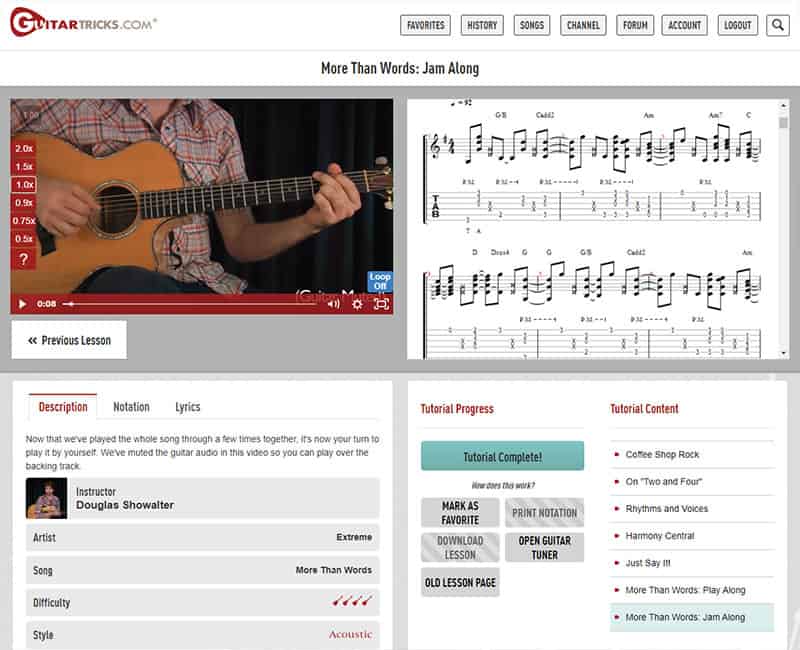
One area where Guitar Tricks shines is its beginner-friendly content. The platform offers a structured "Core Learning System" that guides beginners through the basics of guitar playing. In contrast, TrueFire's beginner content feels a bit overwhelming and disjointed.
Also, GuitarTricks has way more lessons on popular songs, and their private lesson video exchange feature is free.
However, TrueFire has an edge when it comes to intermediate and advanced content.
You can read my detailed review of GuitarTricks here >>
JustinGuitar
For those on a budget, JustinGuitar is a popular free alternative to TrueFire.
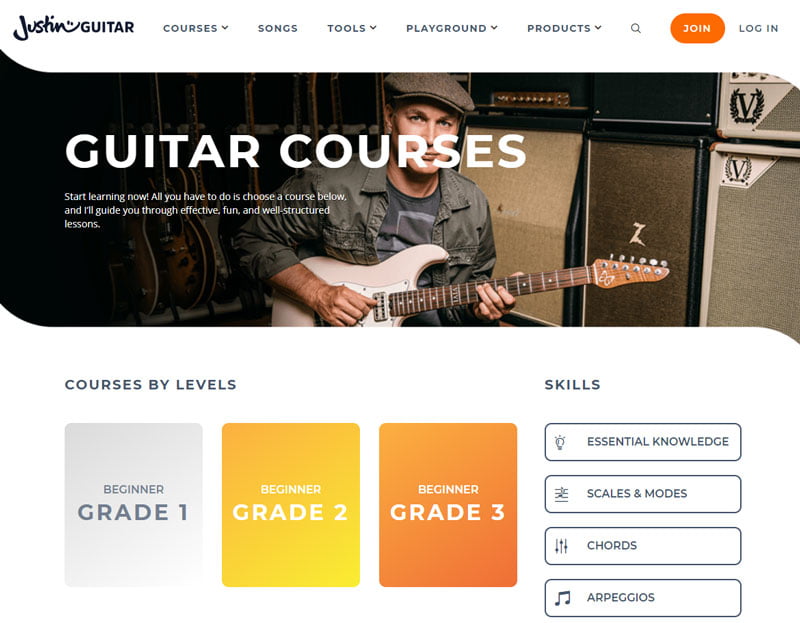
The platform, created by instructor Justin Sandercoe, offers over 1,000 free video lessons.
- It is not truly for free though, how could it be. The site makes money by using video adverts during the YouTube-hosted videos that are intrusive and appear randomly, slowing the pace of learning.
- Also, you have to buy the tablature books that complement the lessons, there is no other way to get the tabs. If you don't do this, it is a definite disadvantage and slows the pace of progress.
While the production value may not be as high as TrueFire's, the educational value of the content is still top-notch, offering a structured curriculum that rivals paid platforms.
However, TrueFire offers a much wider range of content for intermediate and advanced players, more genres to learn, and has way more interactive features like "In the Jam" and "Soundslice" integration.
The amount of content is not even comparable, after all, Justinguitar is a single-teacher site.
Fender Play
This one is a relatively newer entrant in the online guitar lesson market, a sub-business of the iconic guitar brand.
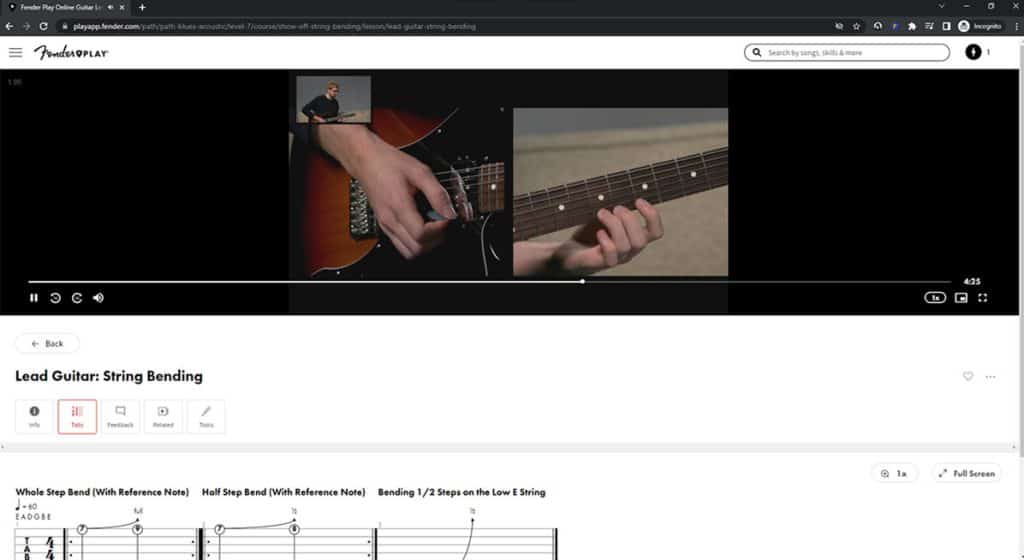
The only advantage of this site is its integration with Fender modeling amps, meaning you can download tone patches used in some lessons to the amp. But that's not really much of an advantage when it comes to learning to play guitar.
TrueFire offers a much larger library of content and more variety in terms of instructors and genres. TrueFire also caters more to intermediate and advanced players, Fender Play is very limited in this regard.
Here is my detailed Fender Play review if you are interested.
I prepared a table on the top competing sites to make it easy to compare:
| Feature | TrueFire | Guitar Tricks | JustinGuitar | Fender Play |
|---|---|---|---|---|
| Lesson Library Size | 52,000+ | 15,000+ | 1,000+ | 3,000+ |
| Beginner Content | Moderate | Strong | Strong | Strong |
| Intermediate Content | Strong | Moderate | Weak | Moderate |
| Advanced Content | Very Strong | Moderate | Very Weak | Weak |
| Live Lessons | No | Yes | No | No |
| Interactive Tools | Strong | Moderate | Weak | Moderate |
| Monthly Price (Basic) | $29 | $19.95 | Free | $19.99 |
| Annual Price (Basic) | $249 | $179.99 | Free | $150 |
| Coupons? | Yes | Yes | N/A | No |
| Free trial? | Yes | Yes | N/A | Yes |
I am not including Jamplay.com here anymore, since even though their domain still exists, all of their lessons have been migrated into TrueFire.
Do I recommend TrueFire?
I highly recommend TrueFire to intermediate and advanced guitar players.
If you're an absolute beginner, I think GuitarTricks is better because of their shorter beginner courses, and the number of popular song lessons.
But you can try both with a free trial and choose for yourself:
Either way you go, once you choose a platform, stick with it, and don't jump around between sites or courses. Practice every day, ideally for at least an hour, and you'll be well on your way to becoming a great player.




So you’ve mentioned that the lesson paths are too long and sometimes incoherent. Do you think breaking them down or reorganizing could help? Just trying to gauge how flexible the learning structure is.
For beginners no, for intermediate and advanced students, yes, but you need to have enough knowledge to already know what you need to improve on, or what you want to study.
This review has convinced me to give TrueFire a shot. I’m a beginner though, so I’m worried about the complexity. Any tips on how to start without getting overwhelmed?
The lessons are structured so that they are not too complex for beginners, moving from easy to progressively more challenging things. So don’t worry about it.
Over 52,000 lessons? That’s insane. How do they even keep track of it all, or make sure new content is fresh and not just redundant?
I think the information in a guitar lesson never really becomes redundant. It can be made better though, or filmed with better gear, etc. But granted, keeping track of this many lessons is probably a challenge.
As a fellow guitar teacher, I’ve found TrueFire’s vast library intimidating but incredibly valuable for higher-level students. Have you explored their In the Jamfeature with any of your classes? I’m curious how effective it is for real-time jamming practice.